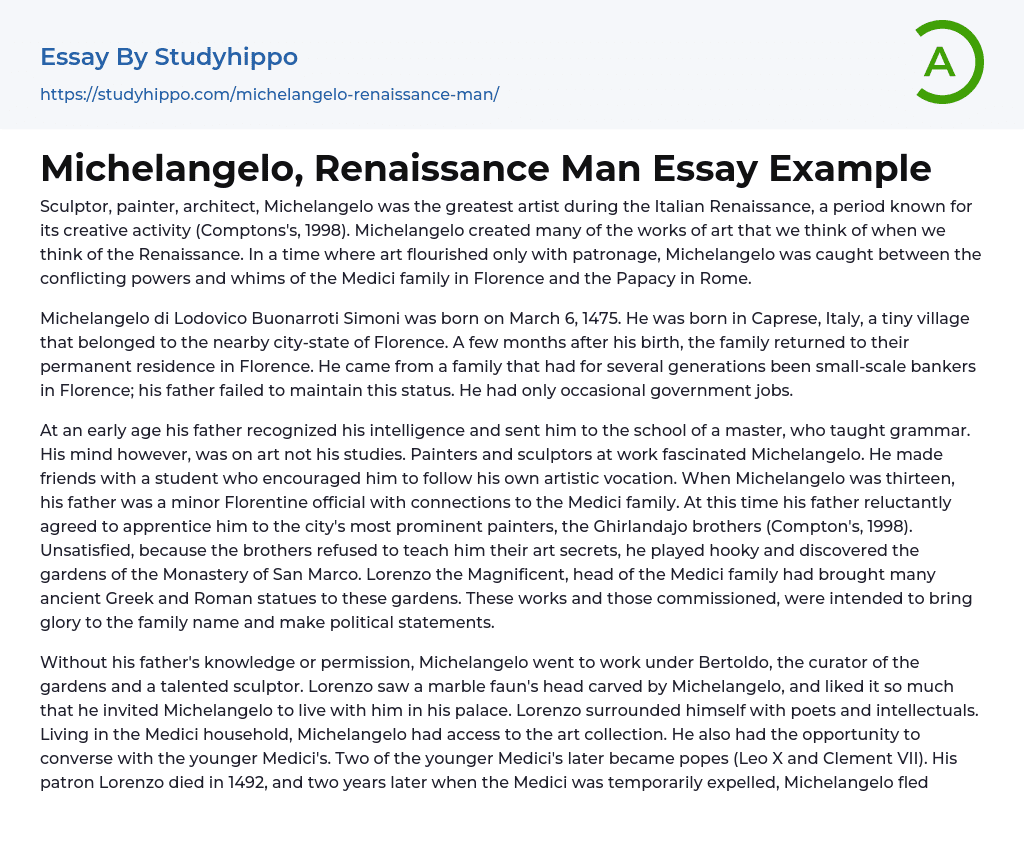Sculptor, painter, architect, Michelangelo was the greatest artist during the Italian Renaissance, a period known for its creative activity (Comptons's, 1998). Michelangelo created many of the works of art that we think of when we think of the Renaissance. In a time where art flourished only with patronage, Michelangelo was caught between the conflicting powers and whims of the Medici family in Florence and the Papacy in Rome.
Michelangelo di Lodovico Buonarroti Simoni was born on March 6, 1475. He was born in Caprese, Italy, a tiny village that belonged to the nearby city-state of Florence. A few months after his birth, the family returned to their permanent residence in Florence. He came from a family that had for several generations been small-scale bankers in Florence; his father failed to maintain this status. He had only occasional government jo
...bs.
At an early age his father recognized his intelligence and sent him to the school of a master, who taught grammar. His mind however, was on art not his studies. Painters and sculptors at work fascinated Michelangelo. He made friends with a student who encouraged him to follow his own artistic vocation. When Michelangelo was thirteen, his father was a minor Florentine official with connections to the Medici family. At this time his father reluctantly agreed to apprentice him to the city's most prominent painters, the Ghirlandajo brothers (Compton's, 1998). Unsatisfied, because the brothers refused to teach him their art secrets, he played hooky and discovered the gardens of the Monastery of San Marco. Lorenzo the Magnificent, head of the Medici family had brought many ancient Greek and Roman statues to these gardens. These works and those commissioned
were intended to bring glory to the family name and make political statements.
Without his father's knowledge or permission, Michelangelo went to work under Bertoldo, the curator of the gardens and a talented sculptor. Lorenzo saw a marble faun's head carved by Michelangelo, and liked it so much that he invited Michelangelo to live with him in his palace. Lorenzo surrounded himself with poets and intellectuals. Living in the Medici household, Michelangelo had access to the art collection. He also had the opportunity to converse with the younger Medici's. Two of the younger Medici's later became popes (Leo X and Clement VII). His patron Lorenzo died in 1492, and two years later when the Medici was temporarily expelled, Michelangelo fled Florence.
Michelangelo made a brief visit to Venice and then went to Bologna. He was hired to succeed a recently deceased sculptor to complete a grand project (tomb ; shrine of St. Dominic). He imposed seriousness on his images by compactness of form that owes much to classical antiquity and to the Florentine tradition.
Michelangelo then went to Rome in 1496 for the first time. There he was able to examine newly unearthed classical statues and ruins. He soon produced his first large-scale sculptor, the over-life-size "Bacchus". One of the few works of pagan subject matter rather than Christian subject matter made by the master, the "Bacchus" relies on ancient Roman nude figures as a point of departure. It rivaled ancient statuary, but it is much more mobile and complex in outline. It is also unique among Michelangelo's works in calling for observation from all sides rather than primarily from the front.
The "Bacchus" led at once to
the commission for the "Pieta", a devotional image of the Virgin Mary supporting the dead Christ on her knees. The patron was a French cardinal and the theme was borrowed from northern European art. The problem for Michelangelo, was to extract two figures from on marble block. This sculpture won him wide fame. He underlined the many contrasts present, of male and female, vertical and horizontal, clothed and naked, dead and alive, to clarify the tow figures.
The artist's prominence, established by the "Pieta" was reinforced at once. After several years of political confusion, in 1501 a republic was once again proclaimed in Florence. Twelve days after the proclamation of the republic, the Wool Guild, commissioned Michelangelo to sculpt a statue of David, for the cathedral of Florence. The character of David and what he symbolizes was perfectly in tune with Michelangelo's patriotic
- Frida Kahlo essays
- Michelangelo essays
- Pablo Picasso essays
- Vincent Van Gogh essays
- Cuban Missile Crisis essays
- Fidel Castro essays
- French Revolution essays
- Han Dynasty essays
- Hiroshima essays
- Imperialism essays
- Jack The Ripper essays
- Mao Zedong essays
- Middle Ages essays
- Mongols essays
- Nelson Mandela essays
- Ottoman Empire essays
- Reformation essays
- Reign of Terror essays
- Renaissance essays
- Roaring Twenties essays
- Romanticism essays
- Samurai essays
- Scientific Revolution essays
- Soviet Union essays
- Architecture essays
- Design essays
- Graffiti essays
- Graphic essays
- Interior design essays
- Painting essays
- Photography essays
- Sculpture essays
- Typography essays




